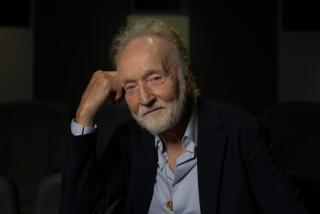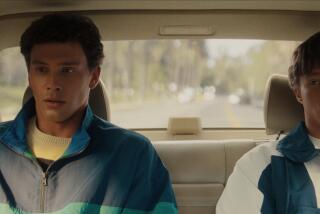A Death Row Tale Finally Gets a Reprieve
For years, a prison-themed screenplay titled “Monster’s Ball” suffered a fate quite common in Hollywood: Although it managed to generate plenty of buzz in the creative community, it just couldn’t seem to get made.
The story of a family of death-row executioners working at a maximum-security prison in the Deep South coupled with a steamy interracial romance was edgy enough to attract such big-name actors as Robert De Niro, Tommy Lee Jones, Marlon Brando and young Wes Bentley of “American Beauty” fame, not to mention Sean Penn and Oliver Stone, who expressed an interest in directing.
But try as the writers might, studios were reluctant to give “Monster’s Ball” a green light.
“In a way, it was a curse,” says Milo Addica, who co-wrote the script with Will Rokos.
Now, after years of patience, angst and a months-long negotiation that left the producer on the verge of a nervous breakdown, “Monster’s Ball” is finally heading for the big screen.
With principal photography complete, Lions Gate Films is considering a year-end release for the movie, and the filmmakers couldn’t be happier.
Despite a meager $2.5-million production budget, producer Lee Daniels has assembled a formidable cast that features Billy Bob Thornton, Heath Ledger, Halle Berry, Sean “P. Diddy” Combs and Peter Boyle. The top three stars have deferred their hefty up-front fees, which Daniels said would normally approach a combined $15 million if this was a big studio release.
While the media often obsess over every behind-the-scenes twist and turn when studios struggle to make big-budget movies such as “Titanic” and “Pearl Harbor,” the quest to make smaller films such as “Monster’s Ball” can be just as frustrating and intense for those concerned.
In the movie, directed by Swiss-born filmmaker Marc Forster, Thornton plays Hank Grotowski, who heads the death row team. His father, Buck (Boyle), is long retired, but Hank’s son Sonny (Ledger) has just joined the “family business.”
One day, as father and son escort Combs’ character to the death chamber, Ledger’s character falls apart. The father angrily lashes out at his son, accusing him of messing up the prisoner’s last walk, after which the son leaves home.
Subsequently Hank discovers a young mother named Leticia, played by Berry, crying for help at the side of the road. Her son has been struck by a car. Hank rushes them to the hospital, not realizing the woman is the widow of the man he executed.
Later, Leticia becomes Hank’s lover, outraging his father because she is black.
Forster stressed that this is not a treatise on capital punishment, unlike the 1995 prison drama “Dead Man Walking,” directed by Tim Robbins.
“The film touches on more subject matters,” Forster said. “‘Dead Man Walking,’ as good as it was, touched on a very specific issue and it was clear it was about capital punishment. This movie isn’t really about capital punishment. It’s about a lot of things. It’s about the consequences of people’s actions.”
The film took five weeks to shoot and some scenes were filmed in the actual death chamber at the Louisiana State Prison in Angola.
“The creepiest thing was, we had so many people in the death chamber that they were making death chamber jokes,” Addica recalled. “I looked at the chair, and there were initials carved into the chair.”
Addica and Rokos, actors by training, auditioned for and landed roles in their own movie. Rokos plays the warden and Addica a member of the death team.
Addica said he’ll never forget one scene that he filmed with Thornton and Ledger.
“When Billy Bob confronts Heath in the prison bathroom, he says, ‘You [messed] up that last man’s walk!”’ Addica recalled. “Then they have this physical fight and we run in there and break up the fight. We had to do that scene six or seven times. It got to the point I didn’t want to go in and break the fight up because I was physically getting hurt.”
Addica and Rokos, who are no longer writing partners, met about 12 years ago while performing in an off-Broadway play called “Fools in the West,” a parody of Sam Shepard’s plays.
“We played brothers,” Rokos recalled. “We just clicked artistically. We ended up writing a screenplay. We thought it was going to be done on a $200,000 budget and we were going to end up playing big parts in it. That was the original plan.”
“We were going back and forth on what to write,” Addica said. “Both of us have similar families in terms of violent households. We knew we wanted to do a story about breaking the cycle of violence that often your father imposes on you. We just didn’t know how.”
They began discussing the various kinds of jobs people have and wondered what it must be like to go to work as an executioner.
The execution business, they soon learned, is generational. The sons of executioners often follow in their father’s footsteps, not unlike the children of ministers, morticians and police officers.
They took the title from a custom in medieval England, where prisoners awaiting execution were called “monsters” and the night before they were put to death, their jailers would hold a macabre drink fest--known as a “monster’s ball”--to send them on their way.
The writers learned other tidbits. For example, in the 1920s and 1930s in America, the task of escorting a condemned convict to the death chamber sometimes fell to professional executioners, who would travel from state to state hauling their own electric chairs, which they powered by running a cord from the chair to a nearby utility pole.
The screenplay was completed in early 1995. The writers initially thought of taking their project to Atlas Entertainment, the production company probably best known for the George Clooney Gulf War adventure “Three Kings.”
“They were good guys, but it just didn’t work out,” Addica recalled. “After that, we made a deal at Fine Line [Features], but they had their own idea about what the movie should be. They put us through a development process we weren’t happy with, but they sent us to Sean Penn. He wanted to do it. He called De Niro.”
But sources said that De Niro wanted $7.5 million for “Monster’s Ball” and, had Penn directed, their fees alone would have pushed the budget to $13.5 million.
Producer Lawrence Bender had taken an option on the script but, Addica said, “he didn’t see it the way we did.”
One major creative issue causing considerable debate was whether to have Leticia’s son die.
“Nobody wanted that kid to die,” Addica said. “They wanted much more of a feel-good ending. I don’t mean that in a derogatory way. There’s more closure and a much sweeter ending with the kid living, but it’s so different from what we envisioned.”
When Bender’s option expired, it was picked up by Daniels, Bentley’s manager.
“It came to me for Wes with Sean Penn directing,” Daniels recalled. “Marlon Brando and Robert De Niro and Wes would play the lead characters. We loved it and wanted to do it. I told the agent, ‘Let’s do it.’ ”
But another year passed, Daniels recalled, and now Oliver Stone and Tommy Lee Jones were interested. For whatever reason, they too dropped out, leaving the producer and screenwriters still without a movie.
After shopping the project around at a number of studios, which he declined to name, Daniels met with executives at Lions Gate.
Mark Urman, who until recently was president of features projects at Lions Gate, said that although the two parties made a good fit creatively, the negotiations took months and even broke off at one point.
“We could not arrive at terms and decided not to make the movie after months of negotiations,” Urman recalled. “We said, ‘Enough!’ We’d been sweating over this from late October to January without successfully signing a deal.”
Urman said that the filmmakers “wanted a lot of guarantees we were not in a position to make--the level of budget, the start date. They wanted assurances we would make the movie before there was [an actors’] strike. With the budget, we couldn’t agree without a cast.... We said, ‘Forget it, let’s move along.’ At that point, there were so many people who were upset, myself included, it was a dose of cold water on all of us.”
Daniels agreed it was a nightmare.
“I thought I was going to have a heart attack,” he said. “I thought we had a deal. I was ready to kill myself. I wanted to make sure we had our director and the cast he wanted. I wouldn’t take no for an answer. Otherwise, why do the film? They walked away from the table and I had a nervous breakdown. After the breakdown, they came to their senses and, wonderfully, gave us $2.5 million to make the movie.”
“The big pivot,” Urman said, “was when Billy Bob decided to make the movie.”
Bentley then bowed out, exhausted from making the new Shekhar Kapur movie “Four Feathers” in Morocco. Daniels sent the script to Ledger, Bentley’s co-star in that movie, and Ledger came on board.
Asked what lessons he learned after going through all these machinations, Daniels replied:
“I think the lesson of ‘Monster’s Ball’ is that the studios need to listen to the actors and what they want because actors know good material. Thank God Lions Gate came to bat, even though they fell out and came back again.”
More to Read
Only good movies
Get the Indie Focus newsletter, Mark Olsen's weekly guide to the world of cinema.
You may occasionally receive promotional content from the Los Angeles Times.










